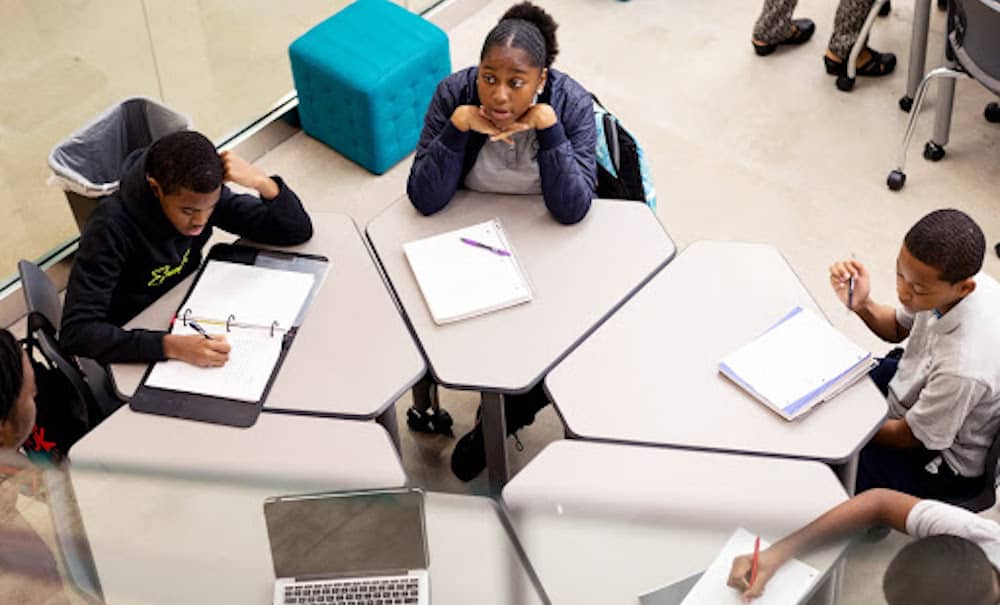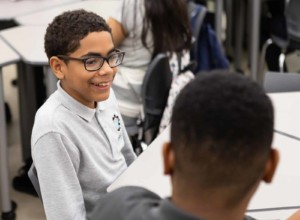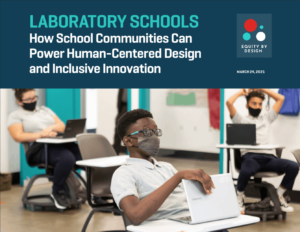How to Reopen Schools: A 10-Point Plan Putting Equity at the Center

With nearly all U.S. school buildings closed for the year, teachers and leaders have scrambled to support remote learning and respond to the emerging needs of 57 million elementary and secondary students. As challenging as it is today, it’s time to begin planning for next year. The damage the pandemic has already caused, its lingering health concerns, and the potential for resurgence make preparation to reopen a complex but urgent affair.
“We have both a historic opportunity and an obligation to create approaches to reopening schools that work for all groups of students all of the time, not just some groups of students some of the time,” writes Russlynn Ali, co-founder, and CEO of the XQ Institute.
Based on insights and resources from practitioners and experts, we have created this 10-point plan, with an aim to help educators reimagine and strengthen systems. In particular, we encourage school and system leaders to consider how the needs of people of color and individuals with disabilities will be affected by re-entry. Many re-entry scenarios present a unique challenge to already vulnerable students and families, thereby compounding the equity implications of the pandemic. Using equitable and innovative re-entry approaches, we have an opportunity to design new solutions together that better meet the needs of all learners.
1. Organize and mobilize. Create a cross-functional team to manage programmatic, staffing, facilities, budget, and communication implications of reopening schools. Empower this team to prepare for re-entry, set and manage metrics that matter most in each domain, and ensure performance for:
- maintaining health, wellness, and safety of the entire school community (e.g., PPE availability, compliance with distancing);
- maximizing student learning and ability to thrive (e.g., access-gap reduction, academic growth);
- supporting educators and staff to adapt and respond (e.g., family satisfaction); and
- securing a strong financial and operational future (e.g., days of cash on hand).
Lindsay Jones, president of the National Center for Learning Disabilities, urges planning teams to “take the steps needed to ensure that all students from all backgrounds can fully benefit” from what might be extended reliance on educational continuity plans.
The team charged with preparation for re-entry should solicit feedback from students, families, teachers, staff, and other stakeholders through a variety of channels, including virtual town halls, social media, and family surveys. This team also holds public accountability and communications responsibility and should coordinate plans with guidance from regional and state agencies.
2. Develop reopening scenarios. Most schools will be told when to reopen, based on regional public health risks, economic demand, and childcare needs. Schools will be responsible for putting structures in place to safeguard health and wellness and responding to student and family needs. Schools will also need to be ready to act if the virus resurges.
EdTrust CEO John King and AFT President Randi Weingarten urged funding for summer learning experiences. “We must help students catch up from lost learning time, which particularly affects our most vulnerable students. We must plan for the future of education in a way that makes good on our promise to provide every child in America with the tools needed to succeed, regardless of geography or demography.”
Reopening in the fall on the regular schedule might be the base case, but alternatives should be considered, including:
- opening early to more quickly address learning gaps
- opening early with safety precautions (as contemplated in California)
- opening on time but ready to shift nimbly to remote learning in the event of resurgence;
- opening on time but with time-shifted (learners on different schedules) and/or place-shifted approaches (some learners in temporary facilities and some learners remote to support distancing); or
- opening later, given a resurgence.
Come fall, schools might have to toggle between on-site and remote learning, stagger attendance, or use a variety of strategies in response to resurgence. System heads with well-developed plans will have the opportunity to influence state reopening guidelines.
As the active ingredients for success with each reopening scenario are identified, Susan Patrick, the president and CEO of the Aurora Institute, reminds us, “equity must be baked into the recipe for effective reopening—into the culture, structures, and into the daily practices.”
“It’s not enough to have one reopening plan, and simply hope that all groups of students will benefit equally,” says Greg Rodriguez, high school director at Brooklyn LAB. “Unless we are careful, intentional, flexible, and creative in our planning, re-entry will work much better for some students than for others.”
It will be critical to maintain flexibility to balance local needs (e.g., serving the children of nurses) with regional realities (e.g., closure of daycare providers for faculty members). Schools will be more effective if they prepare to reduce the friction of transitions.
3. Embrace financial stewardship in the face of uncertainty. Most schools and districts will see a decline in revenue for several years. Public schools must set principles for making hard choices, including how best to balance legal obligations (including maintaining the provision of free and appropriate education) under various resource scenarios. A dynamic and iterative scenario-planning process is required to navigate this unprecedented level of uncertainty.
“As schools think through how to support students upon reentry, they must take full advantage of funds and ensure funds are used wisely for our most vulnerable kids. Now is not the time for small thinking and siloed resources – all of our students, including those with disabilities, must be included and supported,” emphasizes Michael Yudin, former Assistant Secretary of Education for the Office of Special Education and Rehabilitation Services.
Before cutting critical expenses, it’s essential to aggressively preserve revenue. Oliver Sicat, CEO of Ednovate, suggests that budgeting should strive for the optimal combination of defense (budget cuts) and offense (evolution of services). Options for such offense might contemplate different reopening scenarios and consider investments in extra transportation, student home broadband, new talent models that leverage teacher residency models, facilities modifications, and/or technology to support access. These and other innovations might generate or sustain revenue streams through the downturn. With the oversight and proactive involvement of the school board, leaders must rigorously monitor cash inflows and outflows.
Rosalyn Curato of school finance software provider Allovue emphasizes the importance of scenario-planning and priority-based budgeting to provide structure around key choices and to anchor action to the student, our most important stakeholder. “School districts have responded to COVID-19, embracing how budgets evolve as needs change,” she says. “We must work together to strike the appropriate balance between providing quality education and doing so in a resource-constrained environment.”
Finance should not be siloed; every leader has a stake in student success and therefore plays a pivotal role in scenario-planning. Understanding what you can control and when, communicating proactively and transparently, and creating a culture that can respond and adapt to change will set your organization up for success.
4. Staff and schedule for flexibility and differentiation. Re-entry planning must be guided by the health, safety, and welfare of each member of the school community, as well as their family members.
Schools will need to be ready to support partial quarantine (groups of learners and/or staff working remotely). Some at-risk staff members may need modified duties but may still be able to support remote learning.
It’s likely that in-school hygiene protocols will need to be modified, at least for periods of time. Staggered cohort schedules could minimize contact during transitions. Adjustments to assemblies, lunch, physical education, and electives might reduce transmission.
Given likely reductions in state and local funding, school district and network staffing plans and budgets for 2020-21 should start with a lean base case. In addition, staffing plans should be developed for several social-distancing plans (per the time- and place-shifted scenarios discussed in #3).
It will take more staff to run time-shifted models (i.e., morning and afternoon shifts, a long day with cohorts on three or four staggered schedules, or longer alternating days). These scenarios will be difficult to support with what could be lower state reimbursements and should be approached in coordination with state organizations.
School policies related to travel, new requirements regarding temporary leave (e.g., sick leave, emergency paid sick leave, public health emergency leave) and school safety must be navigated with employee groups. State organizations can help facilitate and provide guidance for these conversations.
If resurgence demands remote learning, schools must acknowledge the challenges teachers will face providing differentiated support remotely. Further, caregivers can face increased stress, reduced schedule control, and barriers to accessing academic language and lessons. Smaller group-based supports (e.g., follow-up, feedback, check-ins, review sessions) matter. Widen the circle of supports to include volunteers, tutors, retirees, or ex-educators. Be sure to engage relevant agencies (e.g., social services, housing). Provide in-person and virtual training to caregivers.
5. Reconnect and reassess. The first week of school (or an early summer kickoff) is a good time to reconnect with students, rebuild culture, and reassess academic and social and emotional growth. The fall is an opportunity to meet learners where they are, support individual learning plans, and shift to competency-based progressions.
Some students may have experienced trauma over the previous six months, and staff and community partners will need to be ready to support those learners. Turnaround for Children recommends rebuilding relationships, resilience, and routines. On re-entry, they recommend focusing on physical, emotional, and identity safety, and empowering students to design and use routine planners. They urge schools to co-create norms and routines and provide tiered support systems at all levels.
An NWEA study predicts a big “COVID-19 slide” in learning. It will be critical to assess where learners are and tailor instruction accordingly. Norm-referenced adaptive diagnostics tools like the MAPS test can provide a quick snapshot of learning levels. Criterion-referenced assessments like i-Ready from Curriculum Associates may provide even more actionable insights.
Following assessment, placement is a difficult and important first-week decision. In traditional elementary schools, students who are more than a year below grade level may benefit from repeating the grade they were in before closure. The alternative is to add more flexible groupings and stronger supports in grade-span groups to accommodate learning differences.
“Planning for our most complex learners and our students with significant support needs from the beginning will help to mitigate issues that might arise later during the reopening process.” says, Kristin Wright, Director of the Special Education Division for the California Department of Education. “This will also help ensure we don’t segregate students with disabilities from their peers without disabilities.”
In reopening, it will also be critical to set and maintain high expectations for academic growth and competency development. In states where test-based accountability is likely to continue, getting students into their grade-level learning experience is important.
John King and Randi Weingarten suggested “increased social-emotional supports, a positive and welcoming school climate, increased instructional time and attention, and effective dropout prevention and re-engagement programs — especially for the most vulnerable.”
Scott Bess, head of Purdue Polytechnic High School, reminds us that mastery is more important than seat time in high school academic progress and credits. “No one knows what the fall will bring,” he says. “Emphasis on projects and mastery ensures educators have a powerful lever to engage and prepare students.”
Jonathan Flynn, who leads family and community engagement at Brooklyn LAB, reminds us to always consider the context of the students’ experiences. “The inequities inside school too often compound the challenges many students face outside of school,” he says.
Karen Cator, CEO of Digital Promise emphasizes the importance of understanding learner variability, and of looking for evidence-based factors and strategies to educate learners across context and needs. “Students always have had variations that impact how they learn, but re-entry is one time that variabilities must be explicitly understood and cared for,” she says.
6. Practice agency and prioritize engagement. Learner agency—including self-awareness, self-management, self-directed learning, and good decision-making—is critical to success in school and life. Whether you’re planning for on-site or remote learning, it’s worth considering how learners can practice agency and providing opportunities for learners to demonstrate ownership over the process and progress of their learning.
The National Center for Learning Differences highlights research-based steps that give students choices in the learning process and offer educators opportunities to monitor their overall progress. Students can use strategies to take ownership over this process (including using a learning plan, participating in an IEP meeting, and learning about their rights and needs). The cultivation of self-advocacy skills becomes even more important for families and educators. As Ace Parsi from NCLD notes, ensuring that children play an active role in their own education is key “to ensure innovative approaches to learning fully include students with disabilities.”
Vulnerable students face more challenges in home-based learning. Students with disabilities often rely on connection with peers and trusted adults, stable routines, and supports the school provides in person. By itself, virtual learning often sets complex learners up for lower success. Schools can help learners navigate requirements by following through on one-on-one outreach such as through phone calls to students and creating additional support structures and incentives to engage students. Non-teaching staff can be deputized for coaching and motivation.
The recently formed Educating All Learners Alliance curates a set of best-in-class tools for instruction and support practices to meet the needs of complex learners.
7. Make use of data and systems to improve educational continuity. The last few months have also underlined the need for every school to have a learning platform to manage content and communication, assignments, and feedback. A good learning-management system helps teachers understand student usage, growth, and mastery, even when they use their own curriculum tools. These few months have also shown how valuable it is to have secure and reliable video-conferencing systems for morning meetings, synchronous classes, advisory sessions, tutoring, and counseling.
After a few months of remote learning, school leaders have a pretty good sense of what’s working and what’s not, who’s learning and who’s not. The next six months present an opportunity to reopen in the fall with more robust plans for learning continuity.
It is imperative that districts modernize their data infrastructure to improve data interoperability. Districts can help improve data interoperability by joining Project Unicorn.
The ability to toggle between on-site and remote learning for some or all learners may be critical for the upcoming year. There are ways schools can support families that lack adequate internet connectivity, appropriate learning devices, suitable working space, and tech support. To improve broadband access, schools can provide hotspots and partner with providers to address infrastructure gaps and provide alternative space for students to access devices while practicing distancing.
We have a once-in-a-generation opportunity to embrace a vision where schools have the data to illuminate how students are doing academically, as well as the power to engage families and students in understanding their own mastery journey.
8. Reimagine approaches to core school systems. Schools, districts, and networks have a historic opportunity to rethink education by placing the needs of complex learners at the center. Here are a few ways to redesign learning models and how schools interact with families and communities:
- Make social and emotional learning central to stated outcomes, priority learning experiences, and reported progress measures.
- Add more learner voice and engagement to help students develop agency and to cultivate authentic learning.
- Move toward competency by recognizing new evidence of learning, promoting learners based on demonstrated proficiency, and helping learners tell their own story.
- Build talent systems that consistently enable a diverse team of skilled, knowledgeable, and devoted educators to build and sustain effective schools.
- Transform school board governance so that boards serve as guardians of the community’s future.
Julia Freeland Fisher, director of education at the Clayton Christensen Institute, urges schools to plan for opportunities like internships and real-world projects that help students build social capital. “When schools reopen their doors, they should open up new networks, too,” she says. “This could include both face-to-face and virtual opportunities for students to forge the sorts of professional connections and mentors that wealthy students might take for granted.”
9. Iterate and communicate. Update academic, schedule, technology, and facilities plans based on what’s working. Reopening presents the opportunity for you to make your ideas for improvement reality.
Translate an ambitious and hopeful vision into a well-rounded, feasible plan. The League of Innovative Schools takes on big challenges, mobilizing educators, technology, and learning systems to help districts meet those challenges.
As you do something similar, be sure to frequently communicate any updates or changes in protocols, schedules, or options to all stakeholders. The weekly video updates from Broward County Superintendent Robert Runcie are a great example of a big system iterating, improving, and communicating effectively. In neighboring Miami-Dade County Schools, communication with learners and parents via Remind has increased fivefold.
10. Consider the worst but model the best. If anything, this crisis has taught us to expect the unexpected. No one imagined a pandemic that would shut down the global economy. You should anticipate that things will be different than you assume—and prepare contingency plans for heightened need.
We must prepare for re-entry in the shadow of the second wave of virus resurgence. Strong re-entry plans will “all come together” when systems to maintain school community health prove resilient in the face of such resurgence. This will likely entail:
- operational systems to effectively monitor and enable evidence-based communication and decision-making throughout the entire period in advance of a vaccine;
- family and community partnerships at regulatory and practical levels, including coordination with the department of health, local social service agencies, and innovative welfare services;
- dedicated staff capacity for the multifunctional team directing re-entry, ensuring that responses are coordinated and progress and setbacks are overseen;
- ongoing, direct communication with key stakeholders, especially families, students, and staff; and
- robust data systems to track health, safety, and learning inputs, outputs, and outcomes.
As we return to school, there will be an unprecedented need for mental health services, food, and child care. One of the most important partnerships for schools will be with the public health sector to ensure coordination on testing capacity, contact tracing, and serological surveillance. No entity stands poised to ensure that schools have an equitable and effective effort to support these interventions. The consequences of inadequate preparation for immunocompromised individuals and families, in particular, are unacceptable.
It’s clear that we cannot plan for a normal school year. But it’s also clear we have an opportunity to create new and better normal if we consider the needs of all learners in re-entry. “We will do our educators and students a disservice if we put all our efforts toward ensuring the 2020-21 school year looks just like last year,” says Richard Culatta, president of ISTE. “This is a once-in-a-generation moment to rebuild schooling in a way that honors the unique strengths, interests, and abilities of students. This disruption has underscored the need to think beyond rigid schedules and place-based learning, and instead allow for innovation in pedagogy and delivery.”
As natural and human-made systems collide in unprecedented ways, young people are growing up in a world where novelty, complexity, and mutuality are the norm. How we respond in adaptive, thoughtful, inclusive, and creative ways will be the most important lessons we teach.
For more see:
- Educating All Learners During COVID-19: An Alliance Emerges to Provide Support for Virtual Special Education Services
- We can rise to the challenge of educating students with disabilities during COVID-19
- During the COVID-19 pandemic, how do we ensure that learning moves forward for all learners, especially students with disabilities?
- Hard Reset: What Will Be New Post Pandemic
- Teacher2Teacher educator resources for equity and inclusion
- 9 Ways Schools Will Look Different When (And If) They Reopen (NPR)
- Learning From Post-Katrina (Afton Partners)
Stay in-the-know with innovations in learning by signing up for the weekly Smart Update.
Getting Smart has launched the Getting Through series to support educators, leaders, and families on the path forward during such an uncertain time. This series will provide resources and inspiration as we face long term school closures, new learning environments, and address equity and access from a new lens. Whether you are just getting started with distance or online learning, or you’ve had plans in place and have the opportunity to share your work and guidance with others, there is a place for your voice and an opportunity to learn.
We’re going to get through this together, and we invite you to join us. Please email [email protected] with any questions or content you’d like considered for publication. We also invite you to join the conversation and on social media using #GettingThrough.

Eric Tucker








Nicholas Hobar
I'm sharing a vision that fits under your "reimagine approaches to core school systems" and supports a new dynamic learning model. It builds the case for a paradigm shift from "technology integration" to "learning integration" to support the many strategies offered in your article. https://www.learningfront.com/Media/LF_Vision_2020.pdf
Charles Catalano
These resources and information are very useful and highlight how complex the road ahead is. In light of that, and considering a comment made in Tom Vander Ark's A New Way Forward panel on April 28th about how helpful it would be to see what other school system's re-entry plans were, I'd suggest that Getting Smart, A New Way Forward, and other partners jointly conduct a team- and project-based MOOC to allow literally thousands of educators to explore these principles and learn from each other as they work through their practical planning. The heart of the online experience would not be the content but the community, and the social and action learning that the MOOC would facilitate over a set time period (e.g. 3 to 6 weeks). There are numerous ways that the project work/course deliverable could be conceived, but one example illustrating a simple and practical approach would be the creation of a customized presentation that communicates the re-entry strategy and process, targeted at relevant stakeholders. This of course begs many more details on a feasible approach, but this is offered as initial food for thought in light of the extraordinary circumstances.